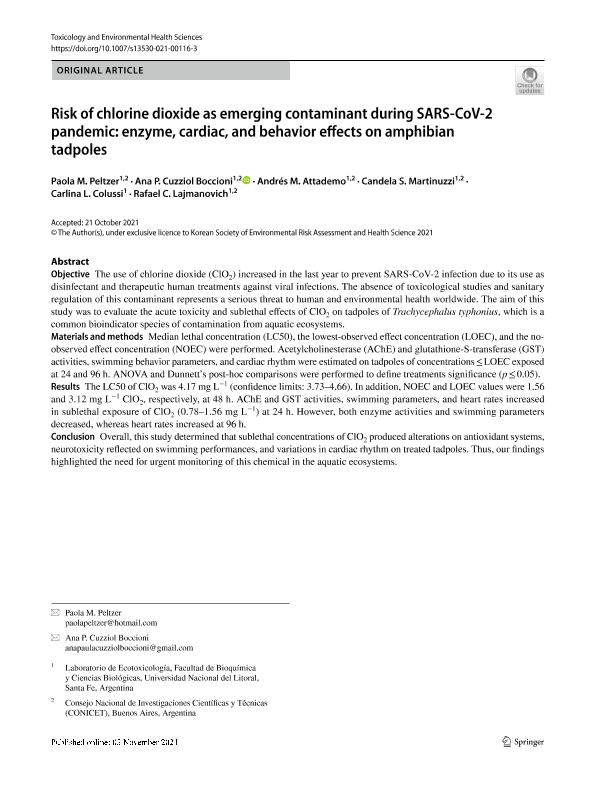Artículo
Risk of chlorine dioxide as emerging contaminant during SARS-CoV-2 pandemic: enzyme, cardiac, and behavior effects on amphibian tadpoles
Peltzer, Paola ; Cuzziol Boccioni, Ana Paula
; Cuzziol Boccioni, Ana Paula ; Attademo, Andres Maximiliano
; Attademo, Andres Maximiliano ; Martinuzzi, Candela Soledad
; Martinuzzi, Candela Soledad ; Colussi, Carlina Leila; Lajmanovich, Rafael Carlos
; Colussi, Carlina Leila; Lajmanovich, Rafael Carlos
 ; Cuzziol Boccioni, Ana Paula
; Cuzziol Boccioni, Ana Paula ; Attademo, Andres Maximiliano
; Attademo, Andres Maximiliano ; Martinuzzi, Candela Soledad
; Martinuzzi, Candela Soledad ; Colussi, Carlina Leila; Lajmanovich, Rafael Carlos
; Colussi, Carlina Leila; Lajmanovich, Rafael Carlos
Fecha de publicación:
03/11/2021
Editorial:
Elsevier
Revista:
Toxicology and Environmental Health Sciences
ISSN:
2005-9752
e-ISSN:
2233-7784
Idioma:
Inglés
Tipo de recurso:
Artículo publicado
Clasificación temática:
Resumen
Objective The use of chlorine dioxide (ClO2) increased in the last year to prevent SARS-CoV-2 infection due to its use as disinfectant and therapeutic human treatments against viral infections. The absence of toxicological studies and sanitary regulation of this contaminant represents a serious threat to human and environmental health worldwide. The aim of this study was to evaluate the acute toxicity and sublethal efects of ClO2 on tadpoles of Trachycephalus typhonius, which is a common bioindicator species of contamination from aquatic ecosystems. Materials and methods Median lethal concentration (LC50), the lowest-observed efect concentration (LOEC), and the noobserved efect concentration (NOEC) were performed. Acetylcholinesterase (AChE) and glutathione-S-transferase (GST) activities, swimming behavior parameters, and cardiac rhythm were estimated on tadpoles of concentrations≤LOEC exposed at 24 and 96 h. ANOVA and Dunnett’s post-hoc comparisons were performed to defne treatments signifcance (p≤0.05). Results The LC50 of ClO2 was 4.17 mg L−1 (confdence limits: 3.73–4.66). In addition, NOEC and LOEC values were 1.56 and 3.12 mg L−1 ClO2, respectively, at 48 h. AChE and GST activities, swimming parameters, and heart rates increased in sublethal exposure of ClO2 (0.78–1.56 mg L−1) at 24 h. However, both enzyme activities and swimming parameters decreased, whereas heart rates increased at 96 h. Conclusion Overall, this study determined that sublethal concentrations of ClO2 produced alterations on antioxidant systems, neurotoxicity refected on swimming performances, and variations in cardiac rhythm on treated tadpoles. Thus, our fndings highlighted the need for urgent monitoring of this chemical in the aquatic ecosystems.
Palabras clave:
ANURANS
,
CHLORINE DISINFECTANT
,
COVID-19
,
SUBLETHAL TOXICITY
Archivos asociados
Licencia
Identificadores
Colecciones
Articulos(CCT - SANTA FE)
Articulos de CTRO.CIENTIFICO TECNOL.CONICET - SANTA FE
Articulos de CTRO.CIENTIFICO TECNOL.CONICET - SANTA FE
Citación
Peltzer, Paola; Cuzziol Boccioni, Ana Paula; Attademo, Andres Maximiliano; Martinuzzi, Candela Soledad; Colussi, Carlina Leila; et al.; Risk of chlorine dioxide as emerging contaminant during SARS-CoV-2 pandemic: enzyme, cardiac, and behavior effects on amphibian tadpoles; Elsevier; Toxicology and Environmental Health Sciences; 2021; 3-11-2021; 1-11
Compartir
Altmétricas



